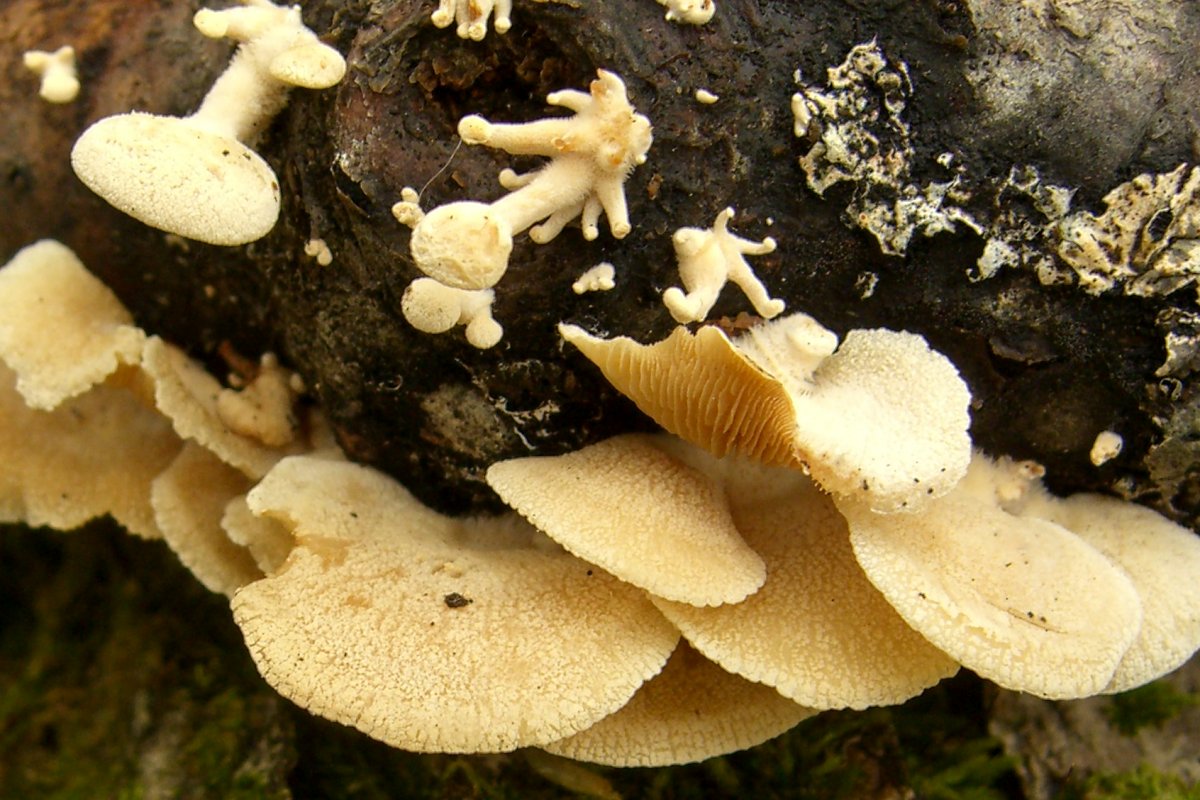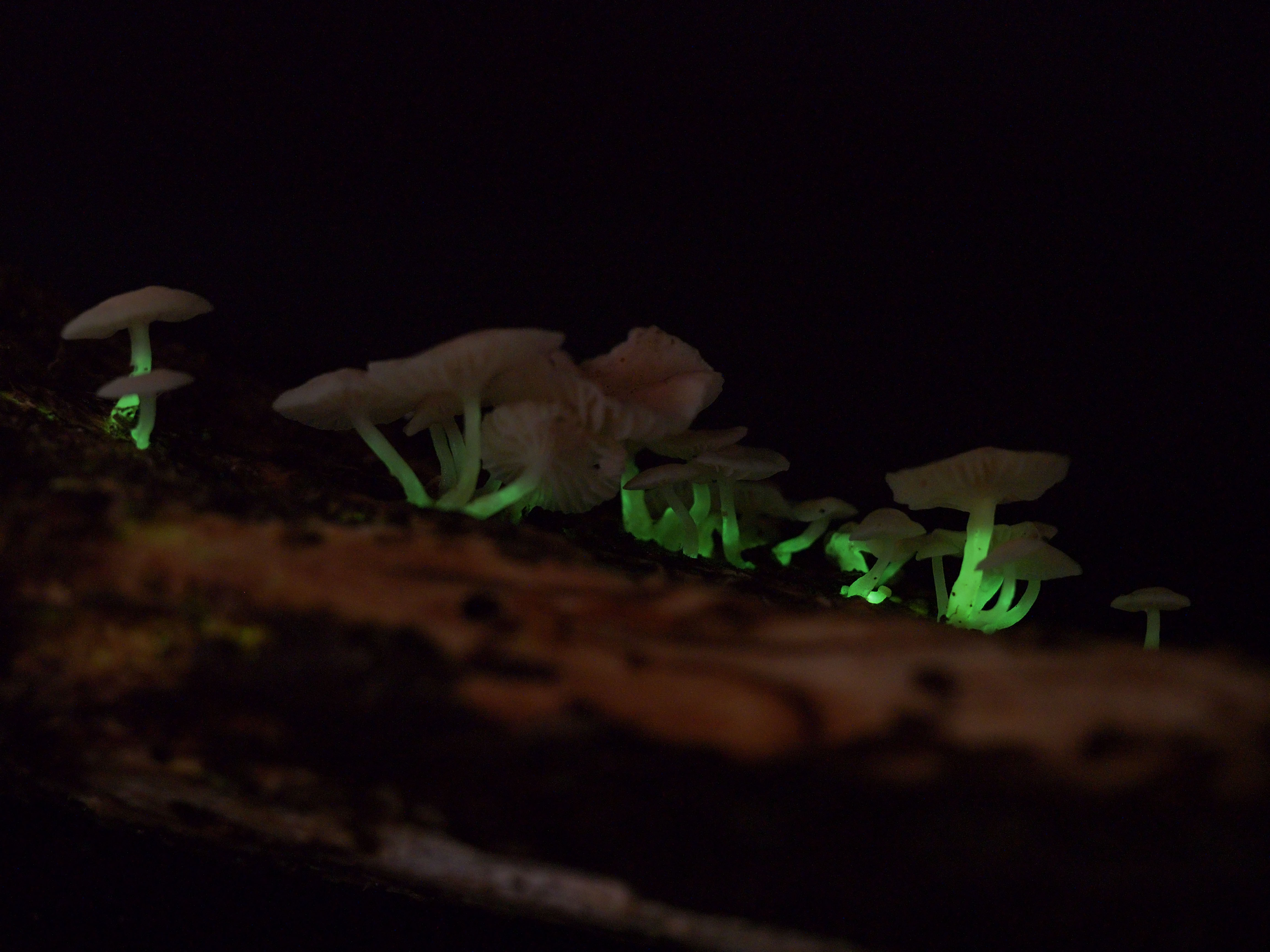|
Foxfire
Foxfire, also called fairy fire and chimpanzee fire, is the bioluminescence created by some species of fungi present in decaying wood. The bluish-green glow is attributed to a luciferase, an oxidative enzyme, which emits light as it reacts with a luciferin. The phenomenon has been known since ancient times, with its source determined in 1823. Description Foxfire is the bioluminescence created by some species of fungi present in decaying wood. It occurs in a number of species, including '' Panellus stipticus'', '' Omphalotus olearius'' and '' Omphalotus nidiformis''. The bluish-green glow is attributed to luciferin, which emits light after oxidation catalyzed by the enzyme luciferase. Some believe that the light attracts insects to spread spores, or acts as a warning to hungry animals, like the bright colors exhibited by some poisonous or unpalatable animal species. Although generally very dim, in some cases foxfire is bright enough to read by. History The oldest recorded doc ... [...More Info...] [...Related Items...] OR: [Wikipedia] [Google] [Baidu] |
Will-o'-the-wisp
In folklore, a will-o'-the-wisp, will-o'-wisp, or ; ), is an atmospheric ghost light seen by travellers at night, especially over bogs, swamps or marshes. The phenomenon is known in the United Kingdom by a variety of names, including jack-o'-lantern, friar's lantern, and hinkypunk, and is said to mislead and/or guide travellers by resembling a flickering lamp or lantern. Equivalents of the will-o'-the-wisps appear in European folklore by various names, e.g., in Latin, in French, or in Germany. Equivalents occur in traditions of cultures worldwide (cf. ); e.g., the Naga fireballs on the Mekong in Thailand. In North America the phenomenon is known as the Paulding Light in Upper Peninsula of Michigan, the Spooklight in Southwestern Missouri and Northeastern Oklahoma, and St. Louis Light in Saskatchewan. In Arab folklore it is known as . In folklore, will-o'-the-wisps are typically attributed as ghosts, fairies or elemental spirits meant to reveal a path or direction. Thes ... [...More Info...] [...Related Items...] OR: [Wikipedia] [Google] [Baidu] |
Panellus Stipticus
''Panellus stipticus'', commonly known as the bitter oyster, the astringent panus, the luminescent panellus, or the stiptic fungus, is a species of fungus in the family Mycenaceae. It is the type species of the genus ''Panellus''. The fungus was given its current scientific name in 1879, but has been known by many names since French mycologist Jean Bulliard first described it as ''Agaricus stypticus'' in 1783. Molecular phylogenetic analysis revealed ''P. stipticus'' to have a close genetic relationship with members of the genus ''Mycena''. Starting out as tiny white knobs, over a period of one to three months, the mushrooms develop into fan- or kidney-shaped caps that measure up to broad. The caps are orange-yellow to brownish, and attached to the decaying wood by short stubby stalks that are connected off-center or on the side of the caps. Strains from eastern North America are typically bioluminescent, but those from the Pacific coast regions of North America and from ... [...More Info...] [...Related Items...] OR: [Wikipedia] [Google] [Baidu] |
American Turtle
''Turtle'' (also called ''American Turtle'') was the world's first submersible vessel with a documented record of use in combat. It was built in 1775 by American David Bushnell as a means of attaching explosive charges to ships in a harbor, for use against the Royal Navy during the American Revolutionary War. Connecticut Governor Jonathan Trumbull recommended the invention to George Washington, who provided funds and support for the development and testing of the machine. Several attempts were made using ''Turtle'' to affix explosives to the undersides of British warships in New York Harbor in 1776. All failed, and her transport ship was sunk later that year by the British with the submarine aboard. Bushnell claimed eventually to have recovered the machine, but its final fate is unknown. Modern replicas of ''Turtle'' have been constructed and are on display in the Connecticut River Museum, the U.S. Navy's Submarine Force Library and Museum, the Royal Navy Submarine Museum, ... [...More Info...] [...Related Items...] OR: [Wikipedia] [Google] [Baidu] |
Aristotle
Aristotle (; 384–322 BC) was an Ancient Greek philosophy, Ancient Greek philosopher and polymath. His writings cover a broad range of subjects spanning the natural sciences, philosophy, linguistics, economics, politics, psychology, and the arts. As the founder of the Peripatetic school of philosophy in the Lyceum (classical), Lyceum in Athens, he began the wider Aristotelianism, Aristotelian tradition that followed, which set the groundwork for the development of modern science. Little is known about Aristotle's life. He was born in the city of Stagira (ancient city), Stagira in northern Greece during the Classical Greece, Classical period. His father, Nicomachus (father of Aristotle), Nicomachus, died when Aristotle was a child, and he was brought up by a guardian. At around eighteen years old, he joined Plato's Platonic Academy, Academy in Athens and remained there until the age of thirty seven (). Shortly after Plato died, Aristotle left Athens and, at the request ... [...More Info...] [...Related Items...] OR: [Wikipedia] [Google] [Baidu] |
Bioluminescence
Bioluminescence is the emission of light during a chemiluminescence reaction by living organisms. Bioluminescence occurs in multifarious organisms ranging from marine vertebrates and invertebrates, as well as in some Fungus, fungi, microorganisms including some bioluminescent bacteria, Dinoflagellate, dinoflagellates and terrestrial arthropods such as Firefly, fireflies. In some animals, the light is bacteriogenic, produced by symbiosis, symbiotic bacteria such as those from the genus ''Vibrio''; in others, it is autogenic, produced by the animals themselves. In most cases, the principal chemical reaction in bioluminescence involves the reaction of a substrate called luciferin and an enzyme, called luciferase. Because these are generic names, luciferins and luciferases are often distinguished by the species or group, e.g. firefly luciferin or Vargulin, cypridina luciferin. In all characterized cases, the enzyme Catalysis, catalyzes the Redox, oxidation of the luciferin resultin ... [...More Info...] [...Related Items...] OR: [Wikipedia] [Google] [Baidu] |
List Of Bioluminescent Fungi
This list of bioluminscent fungi has more than 125 known species found largely in temperate and tropical climates.Stevani, C. V., Zamuner, C. K., Bastos, E. L., de Nóbrega, B. B., Soares, D. M. M., Oliveira, A. G., Bechara, E. J. H., Shakhova, E. S., Sarkisyan, K. S., Yampolsky, I. V., & Kaskova, Z. M. (2024)The living light from fungi.Journal of Photochemistry and Photobiology C: Photochemistry Reviews, 58, 100654. They are members of the order Agaricales (Basidiomycota) with one possible exceptional Ascomycota, ascomycete belonging to the order Xylariales (with extremely faint light). All known bioluminescent Agaricales are mushroom-forming, white-spored agarics that belong to four distinct Lineage (evolution), evolutionary lineages. The Omphalotus lineage (comprising the genera ''Omphalotus'' and ''Neonothopanus'') contains 12 species, the ''Armillaria'' lineage has 10 known species, while the Mycenaceae, Mycenoid lineage (''Favolaschia, Favolachia, Mycena'', ''Panellus'', ''P ... [...More Info...] [...Related Items...] OR: [Wikipedia] [Google] [Baidu] |
Finnish Language
Finnish (endonym: or ) is a Finnic languages, Finnic language of the Uralic languages, Uralic language family, spoken by the majority of the population in Finland and by ethnic Finns outside of Finland. Finnish is one of the two official languages of Finland, alongside Swedish language, Swedish. In Sweden, both Finnish and Meänkieli (which has significant mutual intelligibility with Finnish) are official minority languages. Kven language, Kven, which like Meänkieli is mutually intelligible with Finnish, is spoken in the Norway, Norwegian counties of Troms and Finnmark by a minority of Finnish descent. Finnish is morphological typology, typologically agglutinative language, agglutinative and uses almost exclusively Suffix, suffixal affixation. Nouns, adjectives, pronouns, Numeral (linguistics), numerals and verbs are inflection, inflected depending on their role in the Sentence (linguistics), sentence. Sentences are normally formed with subject–verb–object word order, alth ... [...More Info...] [...Related Items...] OR: [Wikipedia] [Google] [Baidu] |
Aurora Borealis
An aurora ( aurorae or auroras), also commonly known as the northern lights (aurora borealis) or southern lights (aurora australis), is a natural light display in Earth's sky, predominantly observed in high-latitude regions (around the Arctic and Antarctic). Auroras display dynamic patterns of radiant lights that appear as curtains, rays, spirals or dynamic flickers covering the entire sky. Auroras are the result of disturbances in the Earth's magnetosphere caused by enhanced speeds of solar wind from coronal holes and coronal mass ejections. These disturbances alter the trajectories of charged particles in the magnetospheric plasma. These particles, mainly electrons and protons, precipitate into the upper atmosphere ( thermosphere/exosphere). The resulting ionization and excitation of atmospheric constituents emit light of varying color and complexity. The form of the aurora, occurring within bands around both polar regions, is also dependent on the amount of accelera ... [...More Info...] [...Related Items...] OR: [Wikipedia] [Google] [Baidu] |
Kitsunebi
Kitsunebi (狐火) is an atmospheric ghost lights, atmospheric ghost light told about in legends all across Japan outside Okinawa Prefecture.村上健司編著 『妖怪事典』 毎日新聞社、2000年、134頁。。 They are also called "hitobosu", "hitomoshi" (火点し), and "rinka" (燐火). Overview Kimimori Sarashina, a researcher of local stories, summarizes the features of the kitsunebi as follows: in places where there was no presence of fire, mysterious flames like those of a paper lantern or a torch would appear in a line and flicker in and out, with fires that had gone out sometimes appearing in yet another place, so that if one attempted to chase after what was behind all this, it would disappear in the middle. When they appear between spring and autumn, they show up especially in hot summers and appear easily when it is cloudy when the weather is changing. They are said to appear from ten to several hundred in a line, and just when one thinks that they have incre ... [...More Info...] [...Related Items...] OR: [Wikipedia] [Google] [Baidu] |
Japanese Folklore
Japanese folklore encompasses the informally learned folk traditions of Japan and the Japanese people as expressed in its oral traditions, Tradition, customs, and material culture. In Japanese, the term is used to describe folklore. The Folklore studies, academic study of folklore is known as . Folklorists also employ the term or to refer to the objects and arts they study. Folk religion Men dressed as namahage, wearing ogre-like masks and traditional straw capes (''mino (straw cape), mino'') make rounds of homes, in an annual ritual of the Oga Peninsula area of the Northeast region. These ogre-men masquerade as kami looking to instill fear in the children who are lazily idling around the fire. This is a particularly colorful example of folk practice still kept alive. A parallel custom is the secretive ritual of the Yaeyama Islands, Okinawa Prefecture, Okinawa which does not allow itself to be photographed. Many, though increasingly fewer households maintain a kamidana or ... [...More Info...] [...Related Items...] OR: [Wikipedia] [Google] [Baidu] |
Benjamin Gale
Benjamin Gale (December 14, 1715May 6, 1790) was an American physician, scientist, agriculturist, inventor and political polemicist who was known for his political protests against the New Lights, which resulted in a fifteen year pamphlet war against leader Thomas Clap, and was himself considered a leader of Old Light politics in Connecticut. Gale was born in Jamaica, Queens. After graduating from Yale University, he moved to Killingworth, Connecticut, where he further studied medicine and surgery. Throughout the next decade he would indulge in several business ventures and investments, which led to his invention of the drill plough. He was elected as justice of the peace and state representative in 1747, and would serve in those capacities until 1773 and 1770 respectively. In 1755, Gale would publish his first pamphlet against Thomas Clap, which he wrote as a response against an earlier pamphlet written by Clap. This pamphlet ended up being successful, prompting a pamphlet ... [...More Info...] [...Related Items...] OR: [Wikipedia] [Google] [Baidu] |










